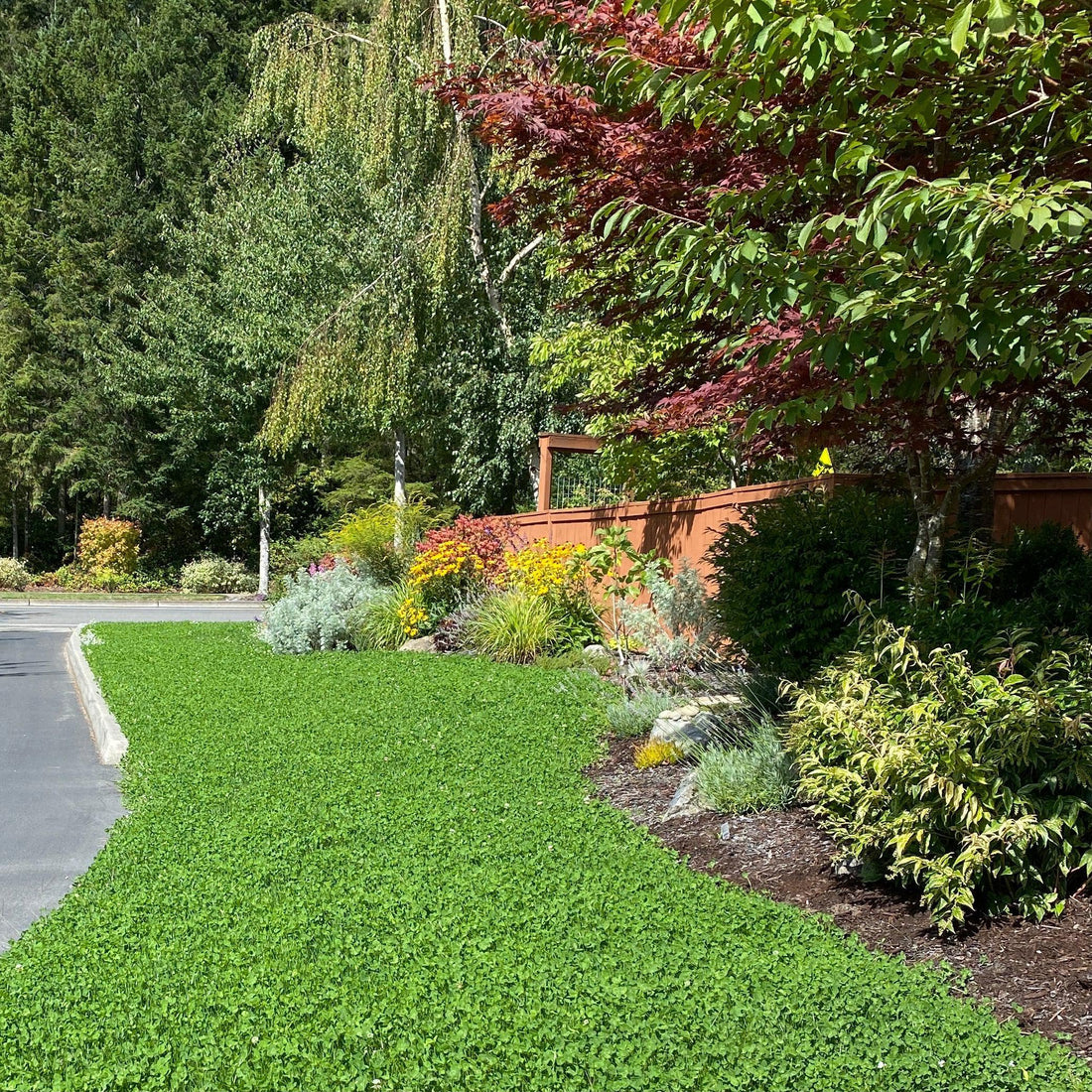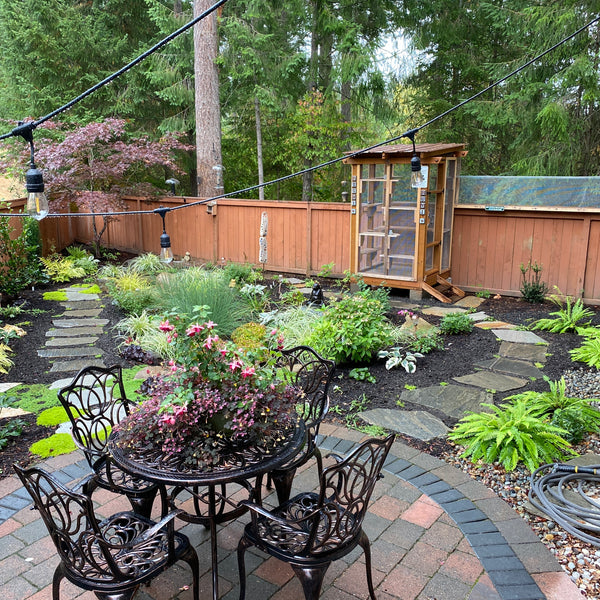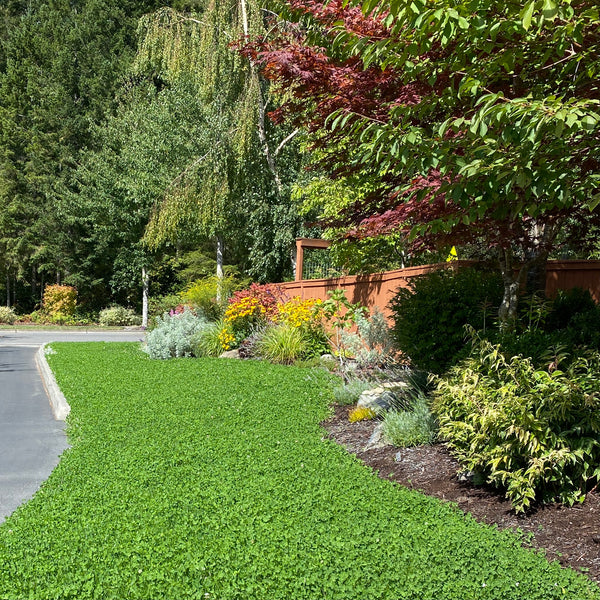
Public Letter to my HOA: Please Get Onboard with Ecolawns
Valerie BurkePublic Letter to my HOA: Please Get Onboard with Ecolawns
I know this is not a shungite post, but it is important enough that I wanted to share.
I love shungite because I love mother Earth and all she provides for us. I believe that taking care of the ground we occupy is part of our responsibility as residents here, and we humans have been doing a piss-pour job of that, overall... in my humble opinion.
So, here's the story behind this letter.
I bought this house for myself - and Shungite Queen headquarters - in spring of 2020. It is a lovely two-story house on an unusual triangle-shaped plot of land that overlooks a small "lake" (actually a runoff pond), which is separated from my house by natural woods.
The house is in the middle of a nice community centered around a golf course. HOAs (homeowners associations) are prevalent here, and of course traditional lawns are very popular. Being the non-traditional person that I am, the first thing I did was rip out all three.
I hired a local landscaper to design and construct an environmentally friendly, low impact garden that connects my front, side and back yards. The back yard (shadiest, near the forest) is a rain garden. The side yard (sunniest) was converted into a food growing area with veggies, apples, berries, and herbs. The front yard was modified such that half the lawn area was converted into a pollinator berm, with the remainder planted as ecolawn (above photo).
The landscape design was approved by the HOA in 2020, but the work was not completed until spring 2021. Fast forward to September 10.
I received a letter stating I am out of compliance with the HOA landscape guidelines and must treat/remove all the "weeds" in my front lawn, because I have "excess weeds." Since there are actually NO weeds in my front lawn, what they are really asking me to do is kill the entire lawn and plant conventional grass.
Hence, my letter.
In the letter, I provide information - complete with citations - about ecolawns and why they are superior and in fact necessary in these times of increased heat and drought, stretched resources, and disappearing pollinators. For anyone with ailing grass or who is just interested in a more environmentally friendly alternative to conventional grass, I urge you to consider an ecolawn. It was not difficult to create - I did it myself, and it turned out beautifully.
If I can do it, you can too!
I don't know what the HOA is going to decide, but I won't go down without a fight in defending my precious little patch of green.
First, A Few Garden Pictures
The first two are my rain garden.
The next two are apple trees - a columnar apple and an espaliered honey crisp.
The last show two of my raised veggie bins.






The Letter
To: Campus Meadows Neighborhood Association
From: Valerie Burke
RE: Response Letter to “Weeds in Front Lawn,” Notice of Violation dated September 10, 2021
Date: September 20, 2021
On September 10, 2021, I received the above notice from the VIS Group management team stating that I have committed a landscaping violation by permitting weeds in my front lawn. The Governing Documents state:
I believe that I am not out of compliance, therefore I am disputing this violation. I think the inspector is mistaken about what she deemed as “weeds,” leading to a misunderstanding.
In the notice, the inspector cited “excess weeds” in the front yard. Since there are actually no weeds at all in the yard, I can only assume that what she misidentified as “weeds” were the primary plants and grasses comprising the lawn.
As a bit of background, I overhauled my front lawn this spring due to the failure of the grass lawn that previously occupied the front yard.
I purchased this house in April 2020. Since that time, I have completed a major landscaping project, in accordance with your design approval (ACC application #000820 approved 11-2-20). The landscape plan was specifically designed around sustainability and earth-friendliness, complete with a rain garden in the back, food and herb growing area on the side, and pollinator berm in the front. I hired an ecofriendly landscape company to help me with the project.
The old grass lawn in front was replaced with an ecolawn, which is more environmentally friendly and uses drastically fewer resources, such as water, gas for mowing, and fertilizer. Please see the photos of my lawn in ADDENDUM 1.
Beyond simply responding to your notice, I have decided to take this opportunity to provide some important information to the association about how we can green up this community – and I am not just talking about greener lawns.
I hope you will accept this letter in the spirit with which it was intended.
I believe that moving away from water-guzzling and chemical-hungry lawns is not just an option but a matter of mounting urgency. As global temperatures rise and droughts ravage on, the resource demands of turf grass lawns will likely become untenable. It’s time for us to think of clovers and dandelions as flowers that attract pollinators, rather than weeds that must be destroyed. When I look at grass lawns, all I can think about is honeybees disappearing and wonder who the next victims will be in our mass extinction.
Lacey Water Resources Specialist Lindsey Fields is a supporter of ecolawns and was very helpful when I consulted her earlier this year – and she represents only one of many experts in favor of moving away from traditional grass lawns.
As an HOA in Washington state, you are in a unique position to join a rapidly growing movement that is turning away from the conformity of mowed turf in favor of naturalized, less thirsty, fire-retardant lawns that support a more diverse ecosystem – with benefits for the entire community.
Please find the following attachments to this letter:
Below are a few key points. You will find more information, footnotes, and references in the attachments, which I hope you find informative.
- Ecolawns are self-fertilizing, weed resistant, dog urine resistant, require less irrigation, support honeybees, and are lush and green all year long - so they are a benefit to the entire neighborhood, city, and planet (see ADENDUM 2).
- Microclover (ADDENDUM 3) is one of the constituents of most ecolawns because it is self-fertilizing (nitrogen fixing), drought tolerant, requires far less water, low growing, green all year, reduces fire danger, and its flowers support bees and other beneficial pollinators. It grows well where grasses struggle – such as on the sandy soil we have here (ADDENDUM 7). Microclover is recommended by Thurston County’s Environmental Health Division, Oregon State University Extension, National Resources Defense Council, and many others - even Bob Vila (ADDENDA 2 and 3).
- Weeds: Clover is not a weed. A weed is defined as a plant that is not valued and of “no benefit” where it’s growing; growing where it is not wanted; a nuisance plant; a plant of detrimental quality; a plant that is not cultivated. The microclover in my ecolawn is highly beneficial, carefully cultivated by University of Oregon over many years, and a critical part of the seed blend, so is not a weed (ADDENDA 3 and 4).
- Conventional grass lawns are an enormous drain on our precious resources. They require more equipment, labor, fuel, and agricultural chemicals than industrial farming. They also offer no benefit whatsoever to bees and other pollinators (ADDENDUM 5).
- HOAs across the US are having to adapt to ecolawns and more earth-friendly landscaping. Already, three states (California, Texas, and Florida) have laws on the books prohibiting HOAs from penalizing property owners for building ecofriendly lawns and landscapes (ADDENDUM 6).
- Feedback from neighbors: I have been flooded with positive comments and inquiries about my lawn – every time I am out front mowing or weeding, neighborhood passersby approach me to comment. I have received only positive comments and, after seeing how mine turned out, several neighbors have expressed interest in replacing their own ailing lawns with similar lawns (ADDENDA 8 and 9).
In conclusion, I contend that my front lawn is already up to community standards – above them, actually. There are no weeds to treat or remove because there are no weeds. The lawn has really improved the neighborhood, rather than being detrimental to it, and I am maintaining and cultivating it properly.
Thank you for your time and consideration.
Sincerely,
Valerie J. Burke
ADDENDUM 1 Photos of My Lawn
Since the inspector did not include photos of my front lawn with the notice, I am including them for your consideration.



ADDENDUM 2 Ecolawns & Their Benefits
You might not be familiar with ecolawns. The seed blends for ecolawns are comprised of carefully cultivated, balanced blends of grasses and other native plants that work together to synergistically support an ecosystem. Another term for this is “xeriscaping.”
Ecolawns are more expensive initially as the seed blends are pricey, and they cannot simply be overseeded onto a conventional grass lawn. The old sod must be removed. But in the long run, ecolawns are worth the investment because they are self-fertilizing, require less irrigation, support honeybees and other pollinators, as well as being lush and beautiful all year long - so they are a benefit to the entire neighborhood.
My ecolawn mix is called Fleur de Lawn (PT755), a flowering mix from Pro Time Lawn Seed in Portland, Oregon. The seed mix includes:[1]
Perennial Ryegrass - Lolium perenne
Hard Fescue - Festuca trachyphylla
Quatro Tetraploid Sheep Fescue - Festuca ovina 'Quatro'
White Yarrow - Achillea millefolium
White Clover - Trifolium repens
English Daisy - Bellis perennis
Sweet Alyssum - Lobularia maritima (annual)
Baby Blue Eyes - Nemophila menziessii (annual)
Strawberry Clover - Trifolium fragiferum
This blend was developed by Oregon State University and is highly regarded, time tested – and free of weeds. I chose it because it creates a symbiotic pollinator habitat between the lawn and garden, besides being drought tolerant and green all summer. You will notice how my lush ecolawn stands out like a green oasis amongst all the brown grass lawns in the neighborhood
The plant mix is mutually compatible and ecologically stable. Because the lawn has not yet overwintered, it is not yet mature – some of the seeds require overwintering before germinating, so currently dominant species will be balanced out by others next spring. Recommendations are to mow it every 3 to 4 weeks, but I have been mowing it every 10 to 14 days so that it more closely matches the other lawns in this neighborhood.
Many agricultural experts and organizations are promoting ecolawns, particularly those concerned about conservation, drought, pollinators, and climate change. For example, The Seattle Times featured ecolawns in this article about ecologically sound lawn care in the Pacific Northwest. [2]
Oregon State University Extension Service posted the article “Ecolawn: Less Work and Water,”[3] which describes ecolawns as low input alternatives to conventional perennial grass lawns, with an excellent discussion of their broad ranging benefits for a community.
There is even evidence that drought tolerant landscaping, equating to lower lawn watering, may lead to cooler nights, according to this USC study.[4]
Here is what Bob Vila has to say about alternative lawn mixes:[5]
“To avoid the hassle of ongoing upkeep or to conserve precious resources like water and gasoline—or for both reasons combined—many today are opting to plant drought-resistant grasses. These “no mow” lawns are the product of seeds specially designed to require minimal mowing. Some homeowners have actually taken things a step further, eschewing grass entirely in favor of alternatives—that is, hardy, low-growing ground covers (or even artificial grass). These lawns can eliminate the problems normally faced in shady yards or on properties subject to the wear and tear brought on by pet dogs. So, before you sod the front lawn or re-seed the backyard, consider your options beyond bluegrass, fescue, and rye.”
Vila recommends fescue grass and microclover, which are key components in my lawn. He explains how microclover fertilizes the soil by drawing in nitrogen, is an ideal companion to grass, is low growing, reduces water evaporation, and is “virtually impervious to pet urine.”
ADDENDUM 3 The Benefits of Microclover
Clover has gotten a bad rap - so undeserved! The fact is that clover is not a weed.
We have been convinced that the “perfect lawn” is green, lush, and completely uniform with no other plants. But perfect for what? This is an outdated human construct that runs counter to the profound environmental challenges we face today. Even though many people like to look at an undivided expanse of green turf grass, we pay a terrible price for this.
In the old days, prior to chemical weed killers and fertilizers, microclover was included in lawn seed mixes. Clover consists of about 300 species of flowering plants in the legume (pea) family.
Microclover and grass actually work well together, as the clover pulls fertilizer out of the air and brings it down to the soil to be absorbed. Microclover varieties of white clover flower less prolifically than standard white clover and tend to spread well into a billowy blanket, so you don't have the same patchy look that you get with regular white clover.
Microclover has the following benefits:
- Self-fertilizing/nitrogen fixing, therefore requires no added fertilizer
- Naturally aerates the soil
- Very hardy, drought tolerant, radically reduces stress on the water supply
- Less fire hazard during times of drought
- Remains green all year
- Low growing
- Supports honeybees and other pollinators
- Deters dandelions and weeds from germinating
- Deters pests such as whiteflies, aphids and scales
- Dog friendly
- Lovely to step on
- Grows well in sandy areas where grasses often struggle, such as we have here
Thurston County’s “Common Sense Guide to Lawn Care” explains how clover is not a weed:[6]
“Clover was once included in grass seed mixtures because it is a broad-leaved plant that is green year-round, fixes nitrogen and improves the soil. As clover-selective herbicides were developed, clover became a ‘weed.” Enjoy the clover – it is an all-natural nitrogen factory for your yard.”
ADDENDUM 4 What is a Weed?
I feel compelled to include this section as I have been accused of the violation of allowing “excess weeds.”
Given that the conventional idea of a lawn is an expanse of only grass, it is understandable how seeing clover in a lawn may lead an uninformed individual to reach an erroneous conclusion of “excess weeds.”
What is a weed, really?
Let’s start with Merriam Webster. A weed is defined as the following:
- A plant that is not valued where it is growing and is usually of vigorous growth, especially one that tends to overgrow or choke out more desirable plants
- A weedy growth of plants
- An obnoxious growth, thing, or person
- Something like a weed in detrimental quality, especiallyan animal unfit to breed from
Other definitions include...
A plant growing where it is not wanted; a nuisance plant; a plant not deliberately cultivated. Weeds compete for nutrients, light and space, depriving cultivated plants of these requirements.
Agriculturist Musa lists the following characteristics and properties of weeds:[7]
- A plant which is prolific and persistent in nature and whose potentialities for harm are greater than their potentialities for good
- A plant growing where it is not desired/unwanted particularly where man is attempting to grow a crop (Shaw 1956 per source)
- Any unwanted plant
- A plant that grows spontaneously in a habitat that has been greatly modified by human action (Harper 1944 per source)
- A useless, undesirable, and often very unsightly plant of wild growth usually found in land which has been cultivated or in areas developed by man for specific purposes other than cultivation (Thomas 1956 per source)
These definitions are certainly not indicative of any species growing in my yard! All the plants in the ecolawn are beneficial, desired, intentionally cultivated, and have far greater potentialities for good than harm.
ADDENDUM 5 Conventional Lawns are an Ecological Nightmare
I believe the time has come for us to revise our definition of the perfect lawn. I realize that this may butt up against conventional proclivities, but we collectively share a higher calling as stewards of the earth. After all, it’s our one and only home, and we have no alternatives once we F!*K it up. This has never been more painfully clear than over the past few summers with wildfires drawing ever closer to our neighborhood.
Just this past month, there have been two serious fires near my home on Campus Park Drive!
Conventional turf grass lawns are an ecological disaster. Consider the following statistics:
- Grass lawns are the most grown “crop” in the US – and not one anyone can eat. Grass lawns require more equipment, labor, and fuel, and use more agricultural toxins than industrial farming. There are three times more acres of irrigated lawn in the US than irrigated corn.
- According to Scientific American, the National Resources Defense Council reports that conventional lawns require the equivalent of 200 gallons of drinking water per person per day.[8]
- According to a NASA analysis, Americans use ten times more fertilizer on lawns per acre than they do on food crops - 90 million pounds annually – an enormous contributor to climate change.[9]
- Every year in this country, lawns consume nearly 3 trillion gallons of water, 200 million gallons of gas and 70 million pounds of pesticides.
- The greenhouse gas emissions from lawn care (from fertilizer and pesticide production, watering, mowing, leaf blowing and other lawn management practices) was found to be four times greater than the amount of carbon stored by grass according to a University of California-Irvine study. In other words, conventional turf grass lawns produce more CO2 than they absorb - and that’s before you factor in the gasoline from lawnmowing.
- According to University of Florida ecology and conservation professor Mark Hostetler, when it comes to biodiversity, “lawns might as well be concrete.” They produce no seeds, no nectar or fruit, and few creatures can use them as habitat. This article explains how standard lawns are killing our pollinators.[10]
- According to the Australian Academy of Science, noise pollution from all that mowing has a detrimental impact on a range of wildlife across multiple habitats – not to mention being detrimental to any neighborhood.[11]
ADDENDUM 6 HOAs are Greening Up
A homeowner’s association can be beneficial for a community. You assist with property values and resale, while keeping up aesthetics and prompting people to act when eyesores appear. I get all that, but we can no longer afford to let aesthetics to be the end-all, be-all. Conserving and protecting precious resources must move to the top of the list.
There is no reason we can’t have both - sustainable landscapes and lawns can be functional AND beautiful! I invite you to drive by and look at mine.
There is no evidence that anyone finds my ecolawn even mildly “detrimental to the neighborhood” – and in fact the opposite is true. Since establishing it, I have had half a dozen neighbors and passersby stop and talk to me while I’m out in the yard, all expressing what a fabulous lawn it is, some even asking how they can put in one themselves. One neighbor described it as “the best lawn in the neighborhood.” Not one soul has complained!
Three of my most immediate neighbors have expressed interest in replacing their own ailing lawns with an ecolawn like mine because the turf grass is failing, despite proper care and reseeding.
HOAs across the US are having to adapt to xeriscapes and ecolawns. The good news is, you are in a great position to play a leading role here to educate and encourage homeowners about how to be better environmental stewards.
Already, three states (California, Texas, and Florida) have laws on the books prohibiting HOAs from penalizing property owners for building ecofriendly lawns and landscapes.[12] [13]
Arizona and California even incentivize homeowners by offering rebates of up to $500 per yard for those who convert conventional lawns to native, drought-resistant xeriscapes.
Washington state is well known for leading the fight against climate change, and it won’t be long before HOAs will have no choice in the matter. Why not lead the way? You would be joining a rapidly growing movement that is turning away from the conformity of mowed turf in favor of naturalized, less thirsty lawns that support a more diverse ecosystem – with benefits for the entire community.
The amount of interest in my ecolawn is solid evidence of how popular such a move would be. Believe me, you’d get no complaints about the reduction in lawnmower noise!
There is a good deal of help out there to guide folks about how to go about this. One example comes from two professors at Purdue University College of Agriculture. They wrote a guide for best lawn care practices directed not only toward homeowners but also for turf professionals who maintain spaces like golf courses, just like we have here at Campus Meadows.[14]
ADDENDUM 7 Photos of Neighboring Lawns
All the following photos were taken on the same day as the photos of my front lawn that were attached to my response letter. These are all lawns within a couple blocks of my house - I just took a 10-minute walk.
As you can see, there are numerous “weeds,” especially dandelions. In one photo, there is a large patch of clover.
It looks to me like many lawns are not being “maintained and cultivated so that the lot is not detrimental to the neighborhood.”
Are all these homeowners being issued citations like mine?
Can you really claim that my ecolawn is a neighborhood eyesore compared to those around me?




ADDENDUM 8 Neighbor Letter #1

ADDENDUM 9 Neighbor Letter #2

[1] PT Lawn Seed, Fleur de lawn; https://ptlawnseed.com/collections/eco-and-alternative-lawns/products/fleur-de-lawn
[2] The Seattle Times, Eco-friendly yards | Replacing a grass lawn with a flowery meadow, September 29, 2007; https://www.seattletimes.com/life/lifestyle/eco-friendly-yards-replacing-a-grass-lawn-with-a-flowery-meadow/
[3] Ecolawn: Less work and water, Oregon State University, OSU Extension Service; https://extension.oregonstate.edu/gardening/techniques/ecolawn-less-work-water
[4] Chou B; National Resources Defense Council; Saving water outdoors could bring cooler nights to LA; September 2016; https://www.nrdc.org/experts/ben-chou/saving-water-outdoors-could-bring-cooler-nights-la
[5] Franco, M and Vila, B; Keep off the grass: 5 alternatives to a traditional lawn; Bob Vila; https://www.bobvila.com/articles/grass-alternatives/
[6] Common Sense Guide to Lawn Care; Thurston County Public Health and Social Services, Environmental Health Division; https://www.co.thurston.wa.us/health/ehcsg/pdf/lawn_care.pdf
[7] Definition and characteristics of weeds; Agriculturist Musa, May 2019; https://agriculturistmusa.com/definition-and-characteristics-of-weeds/
[8] D’Costa K, The American obsession with lawns; Scientific American; May 2017; https://blogs.scientificamerican.com/anthropology-in-practice/the-american-obsession-with-lawns/
[9] Ecological impact of lawns; NASA Earth Observatory; November 2005; https://earthobservatory.nasa.gov/features/Lawn/lawn3.php
[10] Your perfect lawn could be killing pollinators, researchers say; Purdue University Agricultural News; August 2017; https://www.purdue.edu/newsroom/releases/2017/Q3/your-perfect-lawn-could-be-killing-pollinators,-researchers-say.html
[11] Parris, K and McCauley, R; Noise pollution and the environment; Australian Academy of Science; https://www.science.org.au/curious/earth-environment/noise-pollution-and-environment
[12] What HOA boards need to know about xeriscaping; HOAleader.com; December 2013; https://www.hoaleader.com/public/What-HOA-Boards-Need-to-Know-About-Xeriscaping.cfm
[13] Law, C; New California law prohibits homeowner associations from penalizing homeowners who do not water their lawns during droughts; Cirrus Law; September 2014; https://www.jgschwartzlawblog.com/new-california-law-prohibits-homeowner-associations-from-penalizing-homeowners-who-do-not-water-thei/
[14] Larson, JL et al; Optimizing pest management practices to conserve pollinators in turf landscapes: Current practices and future research needs; Journal of Integrated Pest Management; Volume 8, Issue 1, July 2017; https://academic.oup.com/jipm/article/8/1/18/3934663
